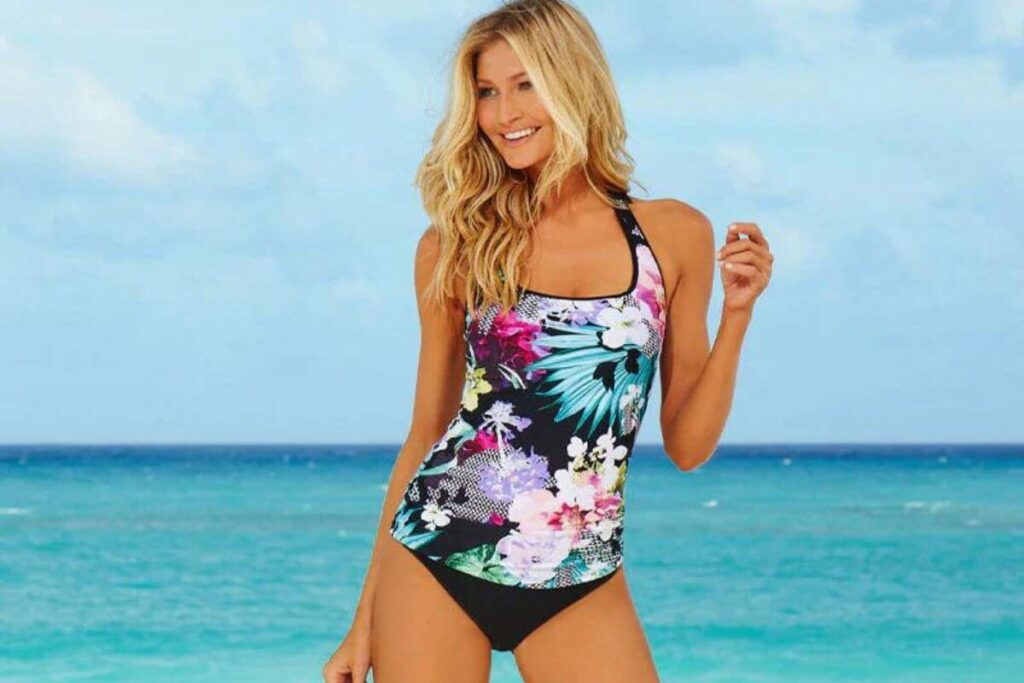When it comes to beach and poolside attire, two terms often make a splash in conversations: “swimsuit” and “bathing suit.” These words, although seemingly interchangeable, carry subtle distinctions in their connotations and historical significance. In this exploration, we’ll wade into the world of aquatic fashion and unravel the nuances between these two terms, helping you navigate the language of swimwear with confidence.
Swimsuit: The Modern Moniker
The term “swimsuit” is the more contemporary of the two and is widely used today. It refers to the attire worn for swimming and other water-related activities. Swimsuits come in a variety of styles, including one-piece, two-piece, tankinis, swim trunks, and more. They are designed to be functional, comfortable, and, in many cases, fashionable.

Evolution of the Term
The term “swimsuit” began to gain popularity in the early 20th century, reflecting a shift towards more practical and comfortable swimwear. It replaced earlier terms like “bathing costume” or “bathing suit,” which were common in the Victorian era.
In the late 19th century, swimwear was vastly different from what we see today. These early “bathing costumes” were characterized by their heavy, modest designs, often covering most of the body. They were primarily made from wool or other non-quick-drying materials, which made swimming a less comfortable experience.
However, as societal attitudes towards leisure and recreation evolved in the early 20th century, so did swimwear. The need for more functional and comfortable attire for water-based activities became evident. Fabrics that dried quickly and allowed for ease of movement in the water began to replace the older, heavier materials.
This shift in design and materials led to the adoption of the term “swimsuit.” It better reflected the changing nature of swimwear, emphasizing not only practicality and comfort but also the emerging fashion aspect of beach and poolside attire. Since then, “swimsuit” has continued to evolve to encompass a wide range of styles and designs, making it the contemporary and preferred term for describing swimwear.
Bathing Suit: A Historical Perspective
“Bathing suit” is an older term with deep historical roots, particularly in the 19th century when swimwear was considerably different from what we see today. These early garments were more conservative, designed not only for swimming but also to maintain modesty, especially by the standards of that era.
During the Victorian period, modesty was paramount, and swimwear reflected these societal norms. Bathing suits from this time often covered most of the body, including arms and legs. They were usually made from heavy materials like wool, which didn’t dry quickly and made swimming a less comfortable experience.
The term “bathing suit” was used to describe these early swimwear garments. The emphasis was not on fashion or comfort but rather on adhering to the strict social conventions of the time. The goal was to cover the body to a degree that it was considered appropriate for public exposure while engaging in water-based activities.
As the 20th century dawned, attitudes towards leisure, fashion, and swimwear underwent a significant transformation. There was a growing emphasis on practicality, comfort, and style. This shift led to the emergence of lighter, more functional swimwear, and the term “swimsuit” gained prominence as it better captured the changing nature of swim fashion.
Today, “bathing suit” is a term that carries a sense of tradition and nostalgia, often evoking images of vintage swimwear from a bygone era. While it is less commonly used than “swimsuit” in modern language, it reflects the historical evolution of swimwear fashion and the societal norms of the time in which it was coined.
Historical Connotations
The term “bathing suit” carries with it a sense of history and tradition, serving as a linguistic link to the past. It can evoke images of a bygone era when swimwear was considerably more conservative, and societal norms emphasized modesty over fashion or comfort.
During the Victorian era, a time marked by strict social conventions and modesty, swimwear was designed with the intention of covering as much of the body as possible. Bathing suits from this period often featured full sleeves and long skirts for women and full-length garments for men. These garments were typically made from heavy materials like wool, which not only made swimming a less comfortable experience but also retained water, further complicating the swimming process.
As the term “bathing suit” gained popularity during this time, it encapsulated the primary purpose of such swimwear: to provide a suitable outfit for engaging in water-based activities while adhering to the stringent modesty standards of the day. It was less about fashion or personal expression and more about conforming to societal expectations.
Today, when one uses the term “bathing suit,” it harkens back to this era of Victorian swimwear, bringing to mind the historical connotations of a time when swimwear was far more reserved and less focused on trends or individual style. It serves as a reminder of how swimwear has evolved to become more practical, comfortable, and fashionable in the modern age.
Regional Variations
It’s important to note that the choice of terminology between “swimsuit” and “bathing suit” can vary by region and culture. The preference for one term over the other is often influenced by local customs, language, and historical factors.
In some regions, particularly those with strong ties to British English, “bathing suit” is still commonly used. This term harks back to the historical influence of British fashion and language on the region.
Conversely, in many parts of the United States and other English-speaking countries, “swimsuit” is the prevailing term. This reflects the broader shift in language usage over time and the influence of changing cultural norms, including a more relaxed approach to swimwear.
In some instances, the choice of term may be generational. Older generations might still use “bathing suit” due to its historical prevalence, while younger generations may favor “swimsuit” as a more contemporary and inclusive term.
Ultimately, whether you say “swimsuit” or “bathing suit” often depends on where you are, the prevailing local culture, and individual language preferences. Regardless of the term used, both convey the same fundamental concept: the clothing worn for swimming and water-related activities.
Modern Usage
In contemporary language and culture, the term “swimsuit” is the more commonly used and widely recognized term to describe the attire worn for swimming and water-related activities. It is the go-to term for referring to swimwear that comes in a diverse range of styles and designs, catering to various preferences and body types.
The prevalence of “swimsuit” in modern language reflects the evolving nature of swimwear and societal attitudes towards it. Today’s swimsuits are designed not only for functionality and comfort in the water but also for fashion and personal expression. They come in an array of styles, including one-piece, two-piece, tankinis, swim trunks, and more. The materials used are lightweight, quick-drying, and often incorporate technology and innovations to enhance the swimming experience.
The term “swimsuit” embraces the fusion of fashion and function in contemporary swim fashion. It is inclusive, accommodating a wide range of swimwear choices for people of all ages and backgrounds. Whether you’re a competitive swimmer, a sunbather on the beach, or someone who enjoys water sports, the term “swimsuit” encompasses the attire that suits your needs and style.
“Swimsuit” reflects the current cultural norms and values placed on individual expression and comfort in swimwear, and it’s the term that resonates most with the modern swim fashion landscape.
Conclusion
In the linguistic realm of aquatic fashion, the terms “swimsuit” and “bathing suit” carry distinct historical and cultural connotations. While “bathing suit” harkens back to a bygone era when swimwear was marked by modesty and societal norms, “swimsuit” has emerged as the contemporary and widely embraced term, encapsulating the fusion of fashion and functionality in modern swimwear.
In today’s diverse and inclusive world, “swimsuit” is the term that best represents the wide array of swimwear options available, from classic one-pieces to trendy two-pieces, tailored for people of all ages and backgrounds. It mirrors the societal shift towards individual expression and comfort in swim fashion, acknowledging that swimwear can be both practical and fashionable.
Ultimately, whether you choose to say “swimsuit” or “bathing suit” may depend on your regional culture, generational influences, or personal language preference. However, in the ever-evolving world of fashion, “swimsuit” has become the modern and all-encompassing term for describing the attire that keeps us stylish and comfortable while making a splash in the water.
FAQs
What is the importance of staying hydrated?
Staying hydrated is crucial for overall health. It helps regulate body temperature, supports vital bodily functions, aids digestion, and keeps your skin healthy. Dehydration can lead to a range of health issues, so it’s essential to drink an adequate amount of water daily.
How can I improve my time management skills?
Effective time management involves setting priorities, creating a schedule, avoiding procrastination, and learning to say no when necessary. It can boost productivity, reduce stress, and create a better work-life balance.
What are the benefits of regular exercise?
Regular exercise offers numerous benefits, including improved physical fitness, enhanced mental well-being, weight management, reduced risk of chronic diseases, and increased energy levels. It also promotes better sleep and overall quality of life.
How can I maintain a healthy diet?
Maintaining a healthy diet involves consuming a variety of nutrient-rich foods, including fruits, vegetables, lean proteins, whole grains, and healthy fats. It’s essential to monitor portion sizes, limit processed foods, and stay mindful of your daily calorie intake.
What are some effective stress management techniques?
Stress management techniques include deep breathing, meditation, exercise, time management, and seeking social support. It’s essential to identify stressors, develop coping strategies, and practice self-care to reduce the negative impacts of stress on your well-being.
How does credit scoring work?
Credit scoring involves evaluating your credit history, payment behavior, and credit utilization to assign you a credit score. This score is used by lenders to determine your creditworthiness when you apply for loans or credit cards.
What are the best practices for job interview preparation?
Effective job interview preparation includes researching the company, practicing answers to common interview questions, preparing questions for the interviewer, and dressing appropriately. It’s also crucial to bring multiple copies of your resume and arrive on time.
What is the difference between climate and weather?
Weather refers to the atmospheric conditions at a specific time and place, such as temperature and precipitation. Climate, on the other hand, is the long-term average of weather patterns in a particular region over an extended period.
How can I start investing in the stock market?
To begin investing in the stock market, you should open a brokerage account, research and select stocks or exchange-traded funds (ETFs), and consider your investment goals, risk tolerance, and time horizon. Diversification and regular monitoring are also important.
What is the significance of renewable energy sources?
Renewable energy sources, such as solar and wind power, are important for reducing greenhouse gas emissions and combating climate change. They also offer a sustainable and environmentally friendly alternative to traditional fossil fuels.
How can I protect my personal information online?
Protecting your personal information online involves using strong, unique passwords, enabling two-factor authentication, being cautious with the information you share, and regularly updating your software and antivirus programs.
What is the difference between a CV and a resume?
A CV (Curriculum Vitae) is a comprehensive document that provides a detailed account of your academic and professional history. In contrast, a resume is a concise summary of your skills and work experience tailored for specific job applications.
How can I improve my public speaking skills?
Improving your public speaking skills can be achieved through practice, preparation, and constructive feedback. Techniques such as visualization, body language awareness, and effective communication can also be helpful.
What are the key benefits of reading regularly?
Regular reading can enhance vocabulary, improve cognitive function, reduce stress, and increase empathy and understanding of different perspectives. It’s also an enjoyable way to expand knowledge and creativity.
How does climate change impact biodiversity?
Climate change can lead to habitat loss, disrupted migration patterns, altered food availability, and increased risk of extinction for many species. Biodiversity is essential for ecosystem stability, and climate change poses a significant threat to it.
Feel free to use these FAQs to provide valuable information on these topics or adapt them to your specific needs.



